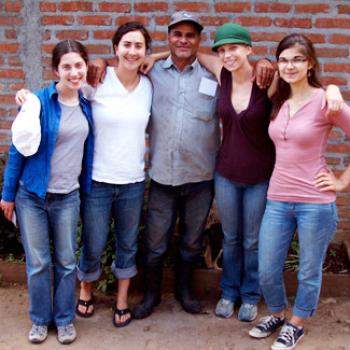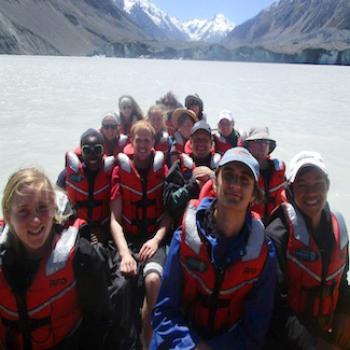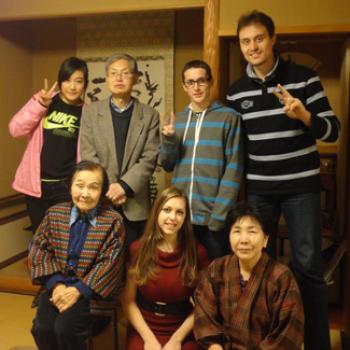On teaching jump rope in Tanzania
Mike Fry ’09
“It may seem unconventional. You’re right - it is. That’s part of what drew me to Oberlin. What I see on a daily basis are students who aren’t afraid to try something completely new, entirely unconventional, and highly improbable. ”

I’ve seen a lot of January winters. The first twenty-one were similar: windy, snowy, and brutally cold. This January was a bit different. This January, the temperature during the day averaged 90 degrees Fahrenheit. This January, I taught jump rope in East Africa.
A bit of background: I’ve been a competitive jump roper since the end of third grade and have competed and taught extensively throughout the U.S. and the world. I want to see jump rope reach Olympic status in my lifetime. It is a one-of-a-kind sport, and the interaction between competitors at international jump rope competitions is unlike anything I’ve ever seen. Kids share techniques, teach one another, collaborate, and show support for their strongest competition. It becomes less about winning, and more about making new friends, gaining a better understanding of the countries represented, and spreading the sport around the world. One world. One rope.
During last summer’s World Championships in Cape Town, South Africa, I found myself awestruck at the abilities of the host team. In 2002, Maarten Goedeme, a jumper from Belgium, introduced jump rope as a competitive sport in South Africa. Six short years later, South African jumpers were performing highly advanced skills—skills that had taken jumpers in countries like the U.S. and Germany over 20 years to develop and master. For some of them, it was their first international competition. They had trained with homemade ropes and shoes ripping at the seams—and they were medaling at world championships. It was truly inspiring. I decided soon thereafter that I wanted to introduce jump rope to youth around the world. Oberlin’s Winter Term made my first venture possible.
My sister, Elizabeth Fry ‘04, had taught in Tanzania for nine months after graduation. This seemed like a good starting point. I researched and contacted schools in several regions, worked out a schedule, and few short weeks later, I was teaching students in Morogoro, Tanzania. I spent the next two and a half weeks teaching and performing in Morogoro, Iringa, Moshi, and the Aga Khan Academy in Mombasa, Kenya. The response was overwhelming. The kids were so excited and so eager to learn. Teachers expressed enthusiasm in coaching teams, and on January 20, 2009, the first Tanzanian jump rope team was formed.
I am extremely encouraged by these early results, and will be returning to Tanzania and Kenya this summer to work intensively with students, teachers, and potential coaches. My goal is to teach jumpers, train teachers, form new teams, and organize workshops and competitions. Ultimately, I hope to work with teachers to form a national governing organization in each country. This would allow them to compete internationally, and give their team members the opportunity to meet jumpers from across Africa and around the world.
Jump rope is the ideal sport for youth in developing countries. It is very inexpensive and accessible to people of all ages. Equipment and space requirements are minimal. The basic skills are easy to learn, and it is fun at any skill level. It is an excellent cross-training method for other sports, and fosters confidence, leadership, and teamwork. The training involved for competition teaches children how to strive for excellence. As the head of one school told me: “It is vital for our students to achieve excellence in some activity—swimming, debate, jump rope, football, etc. How can one become an excellent teacher, an excellent leader, an excellent president—unless they understand this process?”
Beyond the benefits for individuals, jump rope can unite communities, build strong social networks, and promote peaceful cultural exchange. I have seen it light up children’s faces, break down racial barriers, and change lives.
Teaching jump rope in Tanzania may seem unconventional. You’re right—it is. That’s part of what drew me to Oberlin. What I see on a daily basis are students who aren’t afraid to try something completely new, entirely unconventional, and highly improbable. I’m surrounded by cases of atypical ambition and innovation. Perhaps more than on other campuses, students come in with a million different ideas, unsure of which ones to pursue. But when they—when we—do figure out what it is we want, we go for it. No doubts, no mercy. We are the innovators, the risk-takers and the world-changers.
Update: Mike has launched a website for his new program - please visit oneworldonerope.org for more information.
Tags:
You may also like

On what a student co-op in Oberlin has in common with Nicaragua’s strongest union
“As we sat in my host mom Jacinta’s kitchen, I felt like a true partner, fighting alongside the UNAG because we want the same things for the same people.”
Alice Ollstein ’10

On studying away
“I’m very passionate about exploring the world because I believe experiencing many different cultures is integral to developing a wider understanding, as well as a deeper connection to one’s self.”
Peter Nguyen ’16

On her winter term in Tokyo
“I was thrust out of my comfort zone, thanks to Oberlin, and have never been happier.”
Amy Hourcade ’15